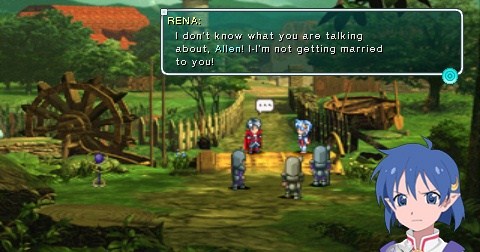Star Ocean: Second Evolution – I Choose You, Rena!
April 13th, 2013
Although Star Ocean: Second Evolution‘s narrative is pretty run-of-the-mill, one minor narrative arc did catch me off guard. Early on in the game, Claude (blonde-haired hero archetype) and Rena (blue-haired introvert archetype) run into the seductive Celine (purple-haired extrovert archetype), who shows the duo a treasure map and sends them off to Krosse Cave to track down the reward. After claiming the “ancient text” and defeating a pair of gargoyles, Claude and Rena find Celine waiting for them at the cave’s exit. She asks Claude if she can join the party. Rena expresses her discomfort for the unreserved Celine to Claude, and the player’s left to make a judgement call. Having grown sick of Rena’s pathetic “I’m a shy country girl” act hours ago, I leapt at the opportunity of adding a little verve to the narrative. Rena expressed her discontent, but I wasn’t all that fazed
Later, the crew arrive in Marze and quickly discover that all the children in the town were stolen by a gang of thieves. Our buddying heroes decide to go after the crooks, but Rena, possibly as a result of my earlier decision, split from the group and joined her big-brother friend, Dias. Claude was a bit upset over the matter, given his not-so-secret crush on Rena, but, again, I wasn’t fazed, after all, Celine seemed like a more than adequate replacement for Rena.
She wasn’t.
The difficulty spikes a little in the forrest on the way to the thieves’ hideout, but unlike before, Rena wasn’t there to heal the party out of every bad situation, and Celine could only cast attack magic. I ended up exhausting my stash of healing items and barely making it out the forrest alive, all the while feeling guilty that I’d, quite maliciously, given Rena the cold shoulder. The forrest and its onslaught of thief soldiers did something which up to that point the game’s copious amount of text dialogue failed to do: it gave me a reason to care about Rena. There’s a moral to this story and I’m sure that you’ve figured it out already: the only way to affect the player is through play itself.
A Few Comments on Star Ocean: Second Evolution
February 10th, 2013
I played this game for 10 hours before giving up. I’m sure it gets better, but who has the time to wade through so much filler? Here are my thoughts:
- A significant portion of Second Evolution‘s gameplay involves reading through protracted talking sequences. The occasionally-voiced anime archetypes blather excessively about nothing and are far too polite for their own good. There’s just no punch to the writing and no conflict to keep the story moving forwards.
- Battles take place in a circular arena where the player can move around enemies to dodge their attacks and target their weak points. The 2D sprites and digital controls weaken the spatial dynamic by making it harder to align and judge the relative position of the two parties.
- The battles run in real-time. The player has several party members, but can only control one at a time while the others follow their pre-set AI behaviours. At any time, the player can switch between party members so as to manually attack, use items, or cast spells. This allows them to micromanage the battles. Since there’s minimal interplay between the different party members (for example, stacking attacks) and party members and enemies, this mechanic is only useful for tending to the AI-controlled characters when they’re low on HP or MP.
- The enemies don’t coordinate their attacks or use their numbers to close in on the player and make use of the spatial dynamic.
- Because the battles lack dynamics and interplay, there’s very little to keep the player engaged. I won most fights by just pressing the attack button a few times and watching the action unfold automatically.
- Similar to the PSone Final Fantasy games, the overworld is rendered in 3D, while the towns and dungeons are pre-rendered images of 3D environments. The awkward angles of the 2D stills, coupled with the sprite avatar and digital controls, sometimes make it tricky to navigate these areas.
- The 2D landscapes are littered with treasure chests that reward exploration. Over time, the player amounts a small bounty of seemingly useless trinkets. A money-for-skills system allows the player to forge these items into something useful. The whole process is bogged down in needless abstraction that’s best remedied with a visit to GameFAQs.
If anyone’s interested in this series, there’s a fan-translation of the original SNES game (which was later remade for the PSP in the same vein as Second Evolution).




 Game Design Companion: A Critical Analysis of Wario Land 4 - $7.99
Game Design Companion: A Critical Analysis of Wario Land 4 - $7.99 Level Design: Processes and Experiences
Level Design: Processes and Experiences Speed Boost: The Hidden Secrets Behind Arcade Racing Design - $5.99
Speed Boost: The Hidden Secrets Behind Arcade Racing Design - $5.99 Adventures in Games Analysis: Volume I - $5.99
Adventures in Games Analysis: Volume I - $5.99







